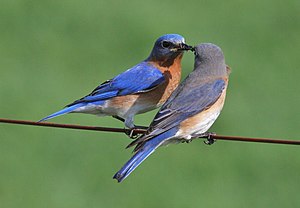 Image via Wikipedia
Image via WikipediaMost Eastern Bluebirds look alike to the human eye. The males have bright blue heads, tails, backs, and wings. The chest is a reddish brown, and the belly is white. The females look similar but are less colorful than males generally.
By October most Eastern Bluebirds have completed a molt to replace old feathers with new. The tips of the new body feathers are brown and make all the bluebirds appear a bit duller in the winter.
 Image via WikipediaThen in the spring, the young will move from the parental territories eventually to another location before choosing a mate. This is called natal dispersal and reduces the chances of inbreeding.
Image via WikipediaThen in the spring, the young will move from the parental territories eventually to another location before choosing a mate. This is called natal dispersal and reduces the chances of inbreeding. The increase of hormones before breeding season stimulates the young birds to become more active, forage further away from home, and discover new territories. Records show that the females tend to disperse farther than the males. The average distance is about 0.7 miles for males and 0.9 miles for the females.
Unfortunately the mortality rate for the young Eastern Bluebirds is 50 percent. However, if the birds make it through their first year, their chances in survival increase. Then their average lifespan is 6 to 10 years. Humans can have a positive or negative impact on the bluebirds. From the late 1800s to the 1960s, Eastern Bluebirds’ population declined almost 90% because of loss of habitat. However, since 1966 the population has increased 2.4% each year due to nesting boxes, better landscaping, and bird feeding practices.
 Providing food for bluebirds during the winter and early spring may increase their chances of survival in bad weather. Bluebirds love to eat mealworms, and they consume about four grams of food per day, about 12% of their body weight. They will also eat suet, nuts, fruit, and berries.
Providing food for bluebirds during the winter and early spring may increase their chances of survival in bad weather. Bluebirds love to eat mealworms, and they consume about four grams of food per day, about 12% of their body weight. They will also eat suet, nuts, fruit, and berries.I hope you are able to continue to watch your bluebird family all winter and don’t forget your heated birdbath. Providing the bluebirds with needed resources not only gives you the chance to watch these beautiful birds up close, it also helps aid in bluebird conservation.
Source:
Wild Bird Guides: Eastern Bluebird by Gary Ritchison
Related articles
Category ›
Bird of the week
 Unknown
Unknown
 Saturday, October 16, 2010
Saturday, October 16, 2010










No comments:
Post a Comment